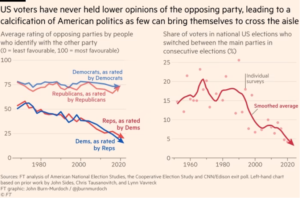We noted last week that the paradox of the 2020 election debacle is that even though 70% of voters say the country is headed in the wrong direction, they went to the ballot box and voted exactly the same way they did in 2020. There was virtually no change. Why? This fascinating analysis below from Financial Times provides some useful and disturbing insights that help explain the conundrum. We have become tribal voters.
At the time of writing, less than five percent of midterm voters have changed allegiance since 2020. This is the second lowest amount of vote-switching recorded in a US election since data collection began in 1952, narrowly beaten by the general election two years ago.
Usually such political tumbleweed would imply apathy, but this uniquely American inertia is instead the result of voters feeling more strongly about politics than ever before. This renders crossing the aisle unthinkable for all but a tiny minority.
In the early 1970s, when asked to rate their feelings towards their political opponents from 0 (icy dislike) to 100 (positively glowing), Republicans and Democrats alike placed their rivals at just above 57. Hardly a warm embrace, but cordial enough. Since then, and especially in the past two decades, that has fallen to a frosty 20. Simultaneously, the share of Americans who say there are big differences between the parties has doubled from 40 percent to 80. Essentially, US politics is calcifying.
https://www.ft.com/content/5ffae475-d995-4fa6-bd1b-c3c70496e299

